Mummified Monks
Gone Beyond in Deep Meditation
Mummified monk is ‘not dead’ and in rare meditative state, says expert
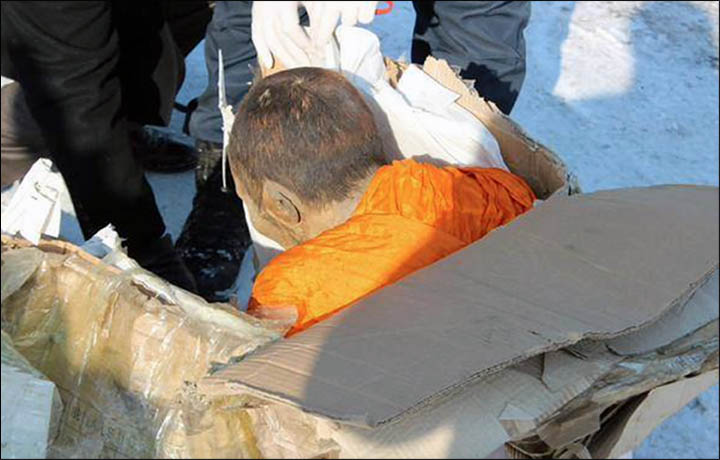 The mummified
remains, covered in cattle skin, were found on January 27 in the
Songinokhairkhan province. Picture: Morning Newspaper
The mummified
remains, covered in cattle skin, were found on January 27 in the
Songinokhairkhan province. Picture: Morning Newspaper
As police say a lama
found in lotus positon was destined for sale on black market, there are claims
it was one step away from becoming a Buddha.
By Kate
Baklitskaya
Forensic examinations are under way on the amazing remains, which are believed to be around 200 years old, having been preserved in animal skin. But one expert has insisted the human relic is actually in 'very deep meditation' and in a rare and very special spiritual state known as 'tukdam'.
Over the last 50 years there are said to have been 40 such cases in India involving meditating Tibetan monks.
Dr Barry Kerzin, a famous Buddhist monk and a physician to the Dalai Lama, said: 'I had the privilege to take care of some meditators who were in a tukdam state.
'If the person is able to remain in this state for more than three weeks - which rarely happens - his body gradually shrinks, and in the end all that remains from the person is his hair, nails, and clothes. Usually in this case, people who live next to the monk see a rainbow that glows in the sky for several days. This means that he has found a 'rainbow body'. This is the highest state close to the state of Buddha'.
He added: 'If the meditator can continue to stay in this meditative state, he can become a Buddha. Reaching such a high spiritual level the meditator will also help others, and all the people around will feel a deep sense of joy'.
Initial speculation is that the mummy could be a teacher of Lama Dashi-Dorzho Itigilov.
Born in 1852, Dashi-Dorzho Itigilov was a Buryat Buddhist Lama of the Tibetan Buddhist tradition, best known for the lifelike state of his body.
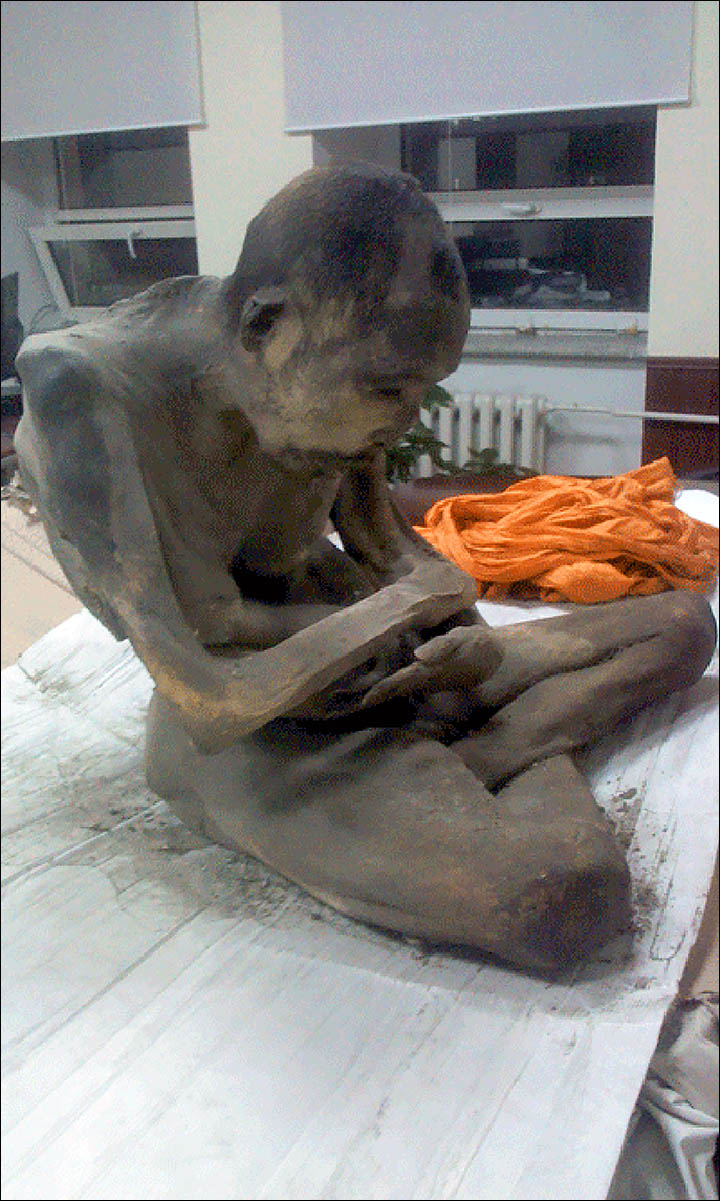
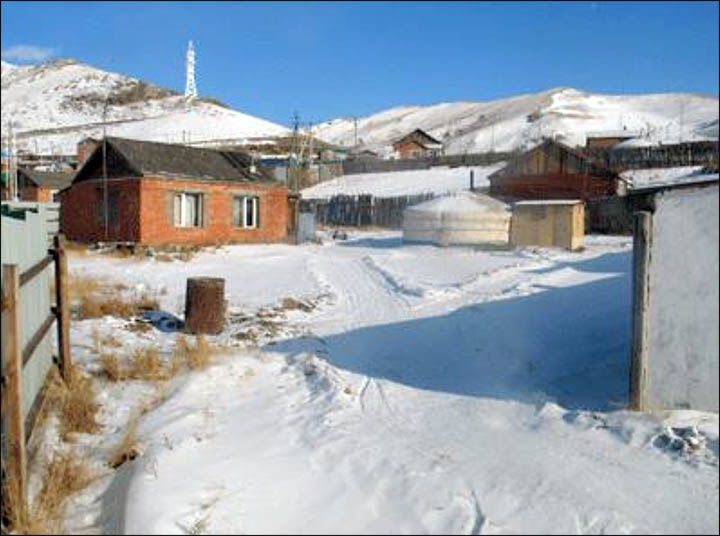
The 'meditating monk' and the house in Mongolia where it was hidden.
Pictures: Morning Newspaper
'This is a sign that the Lama is not dead, but is in a very deep meditation according to the ancient tradition of Buddhist lamas'.
The mummified remains, which were covered in cattle skin, were found on January 27 in the Songinokhairkhan province of Mongolia.
However, there is more to the story and now police have revealed that the monk had been stolen from another part of the country and was about to be sold off.
An unnamed official said that it was taken from a cave in the Kobdsk region by a man who then hid it in his own home in Ulaanbaatar.
He had then been planning to sell it on the black market at a 'very high price', with local media claiming he wanted to take it over the Mongolian border. Police uncovered the plot and quickly arrested a 45-year-old, named only as Enhtor.
According to Article 18 of the Criminal Code of Mongolia smuggling items of cultural heritage are punishable with either a fine of up to 3million roubles ($43,000) or between five and 12 years in prison. The monk is now being guarded at the National Centre of Forensic Expertise at Ulaanbaatar.
From Siberian Times @ http://siberiantimes.com/other/others/news/n0105-mummified-monk-is-not-dead-and-in-rare-meditative-state-says-expert/
Mummified Monk Sits Inside Ancient Buddha Statue
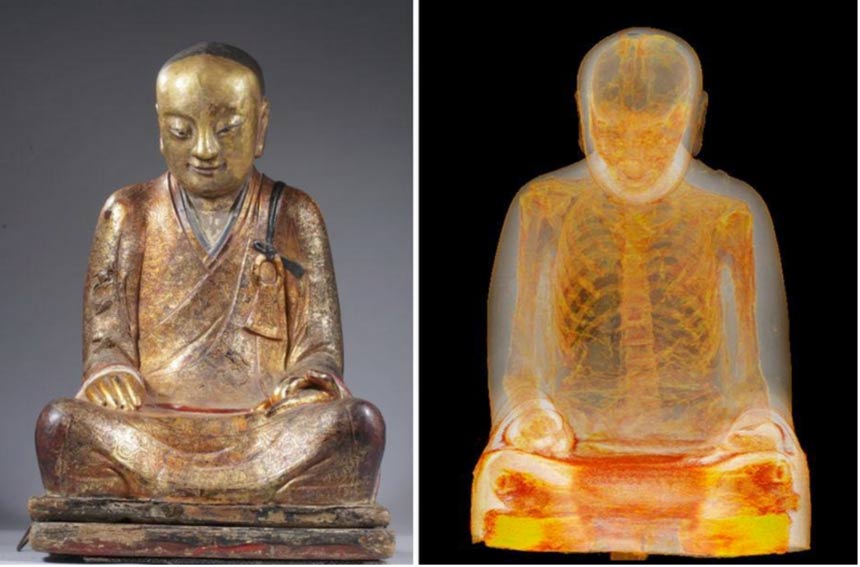
Featured image: Mummified buddhist master
Liuquan. Statue (L), CT scan (R). (Photos: Drents Museum)
Sitting in the lotus position, the mummy fits within the statue perfectly.
"On the outside, it looks like a large statue of Buddha," the museum said in a release. "Scan research has shown that on the inside, it is the mummy of a Buddhist monk who lived around the year 1100."
Glowing through the statue's golden cast, the human skeleton is believed to belong to Buddhist master Liu Quan, a member of the Chinese Meditation School.
To further investigate the mummy, the researchers took the statue to the Meander Medical Center in Amersfoort and carried out an endoscopy and additional CT scans.
They found out that Liu Quan's internal organs had been removed and replaced with scripts covered in Chinese writing.
The museum speculates Liu Quan may have "self-mummified" in order to become a "living Buddha."
Practiced mainly in Japan, self-mummification was a grueling process that required a monk to follow a strict 1,000-day diet of nuts and seeds in order to strip the body of fat. A diet of bark and roots would follow for another 1,000 days.
At the end of this period, the monk began drinking a poisonous tea made from the sap of the Japanese varnish tree, normally used to lacquer bowls and plates. The tea caused profuse vomiting as well as a rapid loss of bodily fluids, possibly making the body too poisonous to be eaten by bacteria and insects.
A living skeleton, the monk was then placed in a stone tomb barely larger than his body, which was equipped with an air tube and a bell.
Never moving from the lotus position, the monk would ring the bell each day to let those outside know that he was still alive. When the bell stopped ringing, the monk was presumed dead, the air tube removed and the tomb sealed.
After another 1,000 days the tomb would be opened to check whether the monk had been successfully mummified. Of the hundreds of monks that tried this horrifying process, only a few dozen actually became self-mummified and venerated in temples as a Buddha.
Researchers aren't certain when or how this monk's organs were then removed and replaced with scripts.
The Buddha statue is currently on display at the National Museum of Natural History in Budapest. It will remain there until May.
Image: A scan reveals the body of a nearly 1,000-year-old Buddhist monk inside the statue of Buddha. Credit: Drents Museum.
Scientists shocked to find mummified monk inside Buddha statue
A recent study on a Chinese Buddha statue carried out in the Netherlands revealed a startling discovery - the statue contains the mummified remains of a Buddhist monk.
Irish Archaeology reports that the study was carried out at the Meander Medical Centre under the supervision of Erik Bruijin, an expert in Buddhist art and culture. He was aided by Reinoud Vermeijeden, a gastrointestinal doctor ,and Ben Heggelman, a radiologist, who carried out a CT scan and an endoscopy. The research confirmed that the statue contained the well-preserved remains of a monk who died around 1100 AD.
The monk is believed to be Chinese master, Liuquan of the Chinese Meditation School, though the researchers have not extrapolated what evidence enabled them to identify the individual.
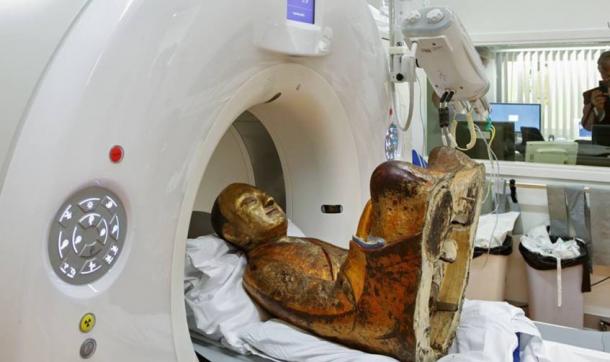
Buddha statue undergoing a CT-Scan. Picture:
Jan van Esch / Meander Medisch Centrum
According to NL Times, a specially-made endoscope was used to study the mummy. Vermeijden took samples of an unidentified material and examined the thoracic and abdominal cavities.
“He made a spectacular discovery – among all kinds of rotten material in the space where there had once been organs, he found paper scraps that are printed with ancient Chinese characters,” writes NL Times. “Heggelman took a CT scan that beautifully shows how the mummy looks inside and took samples of bone material for DNA testing.”
Researchers have suggested that the finding may reflect an example of self-mummification where monks undertook years of grueling rituals to mummify themselves to death. The practice was also widespread in Japan, starting over 1,000 years and continuing until it was banned in the 19th century.
For the first 1,000 days, the monks ceased all food except nuts, seeds, fruits and berries and they engaged in extensive physical activity to strip themselves of all body fat. For the next one thousand days, their diet was restricted to just bark and roots. Near the end of this period, they would drink poisonous tea made from the sap of the Urushi tree, which caused vomiting and a rapid loss of body fluids. It also acted as a preservative and killed off maggots and bacteria that would cause the body to decay after death.
In the final stage, after more than six years of torturous preparation, the monk would lock himself in a stone tomb barely larger than his body, where he would go into a state of meditation. He was seated in the lotus position, a position he would not move from until he died. A small air tube provided oxygen to the tomb. Each day, the monk rang a bell to let the outside world know he was still alive. When the bell stopped ringing, the tube was removed and the tomb sealed for the final thousand day period of the ritual.
At the end of this period, the tomb would be opened to see if the monk was successful in mummifying himself. If the body was found in a preserved state, the monk was raised to the status of Buddha, his body was removed from the tomb and he was placed in a temple where he was worshiped and revered. If the body had decomposed, the monk was resealed in his tomb and respected for his endurance, but not worshiped.
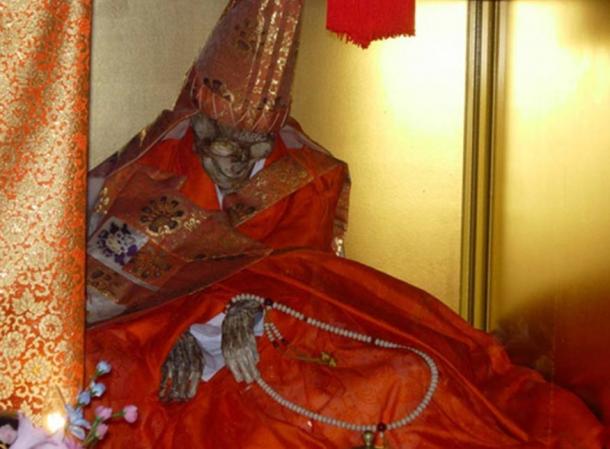
The body of Shinnyokai Shonin, found in
Oaminaka, Japan. He had practiced self-mummification. (self-mummified
monks)
The Buddha statue had recently left China for the first time to go on display as part of a mummy-themed exhibit at the Netherlands’ Drents Museum. The statue is now visiting the Hungarian Natural History Museum until May 2015 and the team’s research is expected to be published in an upcoming monograph.
NL Times writes, “The discovery of the mummy is of great cultural significance. It is not only the only one of its kind, but also the only Chinese Buddhist mummy that is available for scientific research in the West”.
From Ancient Origins @ http://www.ancient-origins.net/news-general/scientists-shocked-find-mummified-monk-inside-buddha-statue-002704
Mysterious
Siberian Mummies: Photos







From Discovery @ http://news.discovery.com/history/archaeology/mummified-monk-sits-inside-ancient-buddha-statue-150223.htm
Sokushinbutsu
Sokushinbutsu (即身仏?) refers to a practice of Buddhist monks observing austerity to the point of death and mummification. This process of self-mummification was mainly practiced in Yamagata in Northern Japan between the 11th and 19th century, by members of the Japanese Vajrayana school of Buddhism called Shingon ("True Word"). The practitioners of sokushinbutsu did not view this practice as an act of suicide, but rather as a form of further enlightenment.[1] Those who succeeded were revered, while those who failed were nevertheless respected for the effort.[citation needed]
It is believed that many hundreds of monks tried, but only 24 such mummifications have been discovered to date. There is a common suggestion that Shingon school founder Kukai brought this practice from Tang China as part of secret tantric practices he learned, and that were later lost in China.[2]
Today, the practice is not advocated or practiced by any Buddhist sect, and is banned in Japan.[3]
The practice was satirized in the story "The Destiny That Spanned Two Lifetimes" by Ueda Akinari, in which such a monk was found centuries later and resuscitated. The story appears in the collection Harusame Monogatari.
In January 2015 the 200 year old body of a mummified monk in lotus position was found in the Songinokhairkhan district of Ulaanbaatar in Mongolia. [4]
In popular culture
- In the Megami Tensei games, a practitioner of Sokushinbutsu known as Daisoujou makes numerous appearances.
- In the InuYasha series, a monk by the name of Saint Hakushin went through the process of Sokushinbutsu in times of famine and war in order to be able to protect his people forever as a living buddha. During the process he realizes the people outside are waiting for him to die and begins to resent them, allowing his undead mummifed body to be convinced to help the main villain with his vast sacred powers.
- In Osamu Tezuka's Phoenix: Karma, Saruta's mentor commits suicide in this manner because he has been driven to despair by the government's misuse of Buddhism for political gain.
- Project Zero II: Crimson Butterfly's Ryokan Kurosawa hostile ghost looks a lot like a Sokushinbutsu.
- In the Anime and Manga Naruto, a being known as the Demonic Statue of the Outer Path has an appearance that is loosely based on this practice, looking somewhat like a mummified monk in the lotus position.
From Wikipedia @ http://en.wikipedia.org/wiki/Sokushinbutsu
For more information about mummification see http://nexusilluminati.blogspot.com/search/label/mummies
- Scroll down through ‘Older Posts’ at the end of each section
Hope you like this
not for profit site -
It takes hours of work every day by
a genuinely incapacitated invalid to maintain, write, edit, research,
illustrate and publish this website from a tiny cabin in a remote forest
Like what we do? Please give anything
you can -
Contribute any amount and receive at
least one New Illuminati eBook!
(You can use a card
securely if you don’t use Paypal)
Please click below -
Spare Bitcoin
change?
For further enlightening
information enter a word or phrase into the random synchronistic search box @
the top left of http://nexusilluminati.blogspot.com
And see
New Illuminati – http://nexusilluminati.blogspot.com
New Illuminati on Facebook - https://www.facebook.com/the.new.illuminati
New Illuminati Youtube Channel - http://www.youtube.com/user/newilluminati
New Illuminati on Google+ @ https://plus.google.com/115562482213600937809/posts
New Illuminati on Twitter @ www.twitter.com/new_illuminati
New Illuminations –Art(icles) by
R. Ayana @ http://newilluminations.blogspot.com
The Her(m)etic Hermit - http://hermetic.blog.com
DISGRUNTLED SITE ADMINS PLEASE NOTE –
We provide a live link to your original material on your site (and
links via social networking services) - which raises your ranking on search
engines and helps spread your info further! This site is
published under Creative Commons Fair Use Copyright (unless an individual
article or other item is declared otherwise by the copyright holder). Reproduction
for non-profit use is permitted & encouraged, - if you give attribution to the work &
author and include all links in the original (along with this or a similar
notice).
Feel free to make non-commercial hard (printed) or software copies or
mirror sites - you never know how long something will stay glued to the web –
but remember attribution!
If you like what you see, please send a donation (no amount is too
small or too large) or leave a comment – and thanks for reading this far…
Live long and prosper! Together we can create the best of all possible
worlds…
From the New Illuminati – http://nexusilluminati.blogspot.com
No comments:
Post a Comment
Add your perspective to the conscious collective